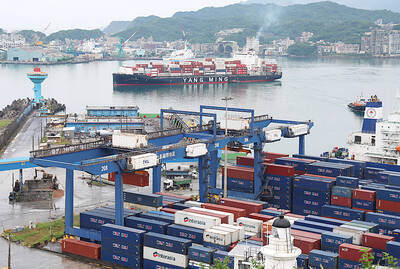Shares in Eli Lilly & Co fell on Friday after an article in a medical journal suggested that the drug maker had long concealed evidence that its well-known antidepressant, Prozac, could cause violent and suicidal behavior.
The accusations were made in yesterday's issue of the British Medical Journal, which said it had turned over documents related to the allegations to the US Food and Drug Administration (FDA).
The FDA was reviewing papers which had been missing for more than 10 years, according to the Journal article, which said they were originally gathered during a lawsuit against Lilly on behalf of victims of a gunman in Kentucky who had reportedly been taking Prozac for a month before going on a rampage.
FDA spokeswoman Kathleen Quinn could not confirm on Friday whether the agency had received the documents mentioned in the medical journal.
But at least one member of the US Congress said he had obtained copies of the documents reportedly given to the FDA.
In a written response, Eli Lilly said: "To our knowledge, there has never been any allegation of missing documents" from lawsuits involving Lilly.
The company also said it tried unsuccessfully to obtain copies of the documents from the British Medical Journal.
"Lilly has consistently provided regulatory agencies worldwide with results from both clinical trials and postmarketing surveillance," including data related to Prozac, the company's statement said.
Eli Lilly's stock fell US$0.75, or 1.3 percent, to US$56.75.
It is unclear what, if any, action might result from the matter. In October, the FDA ordered pharmaceutical companies to include "black box" warnings on the labels of their antidepressants, including Prozac.
The warnings are the strongest restriction the government can impose on pharmaceutical companies, short of banning a drug.
The warnings state that antidepressants increase the risk of "suicidal thinking and behavior in children and adolescents."
British medical regulators have recommended that many antidepressants not be prescribed for children and teenagers, but had not included Prozac in those advisories.
Even if the documents do not prompt legal or regulatory action, they could sully Eli Lilly's image. The company's fortunes have been closely tied to Prozac.
The company has long defended the drug in the face of legal and medical challenges and insisted that it has not suppressed relevant information about the drug.
The report comes at a time of renewed scrutiny of the pharmaceutical industry and the government's process for approving drugs.
US Representative Maurice Hinchey, a vocal opponent of the government's drug-approval process, said on Friday that he had some of the documents cited by the journal article. The congressman, who is a member of the Appropriations Committee, which oversees federal agencies including the FDA, said the documents date back to the 1980s and include memos between Eli Lilly employees.
They "clearly show a link between Prozac and actions of violence perpetrated by people taking the drug against themselves and against others," Hinchey said. "The documents we have show that the company was instructing its employees to hide this information. We're seeing evidence here that it was a conscious act on the part of the company."

CHIP RACE: Three years of overbroad export controls drove foreign competitors to pursue their own AI chips, and ‘cost US taxpayers billions of dollars,’ Nvidia said China has figured out the US strategy for allowing it to buy Nvidia Corp’s H200s and is rejecting the artificial intelligence (AI) chip in favor of domestically developed semiconductors, White House AI adviser David Sacks said, citing news reports. US President Donald Trump on Monday said that he would allow shipments of Nvidia’s H200 chips to China, part of an administration effort backed by Sacks to challenge Chinese tech champions such as Huawei Technologies Co (華為) by bringing US competition to their home market. On Friday, Sacks signaled that he was uncertain about whether that approach would work. “They’re rejecting our chips,” Sacks

Taiwan’s exports soared 56 percent year-on-year to an all-time high of US$64.05 billion last month, propelled by surging global demand for artificial intelligence (AI), high-performance computing and cloud service infrastructure, the Ministry of Finance said yesterday. Department of Statistics Director-General Beatrice Tsai (蔡美娜) called the figure an unexpected upside surprise, citing a wave of technology orders from overseas customers alongside the usual year-end shopping season for technology products. Growth is likely to remain strong this month, she said, projecting a 40 percent to 45 percent expansion on an annual basis. The outperformance could prompt the Directorate-General of Budget, Accounting and

NATIONAL SECURITY: Intel’s testing of ACM tools despite US government control ‘highlights egregious gaps in US technology protection policies,’ a former official said Chipmaker Intel Corp has tested chipmaking tools this year from a toolmaker with deep roots in China and two overseas units that were targeted by US sanctions, according to two sources with direct knowledge of the matter. Intel, which fended off calls for its CEO’s resignation from US President Donald Trump in August over his alleged ties to China, got the tools from ACM Research Inc, a Fremont, California-based producer of chipmaking equipment. Two of ACM’s units, based in Shanghai and South Korea, were among a number of firms barred last year from receiving US technology over claims they have

BARRIERS: Gudeng’s chairman said it was unlikely that the US could replicate Taiwan’s science parks in Arizona, given its strict immigration policies and cultural differences Gudeng Precision Industrial Co (家登), which supplies wafer pods to the world’s major semiconductor firms, yesterday said it is in no rush to set up production in the US due to high costs. The company supplies its customers through a warehouse in Arizona jointly operated by TSS Holdings Ltd (德鑫控股), a joint holding of Gudeng and 17 Taiwanese firms in the semiconductor supply chain, including specialty plastic compounds producer Nytex Composites Co (耐特) and automated material handling system supplier Symtek Automation Asia Co (迅得). While the company has long been exploring the feasibility of setting up production in the US to address